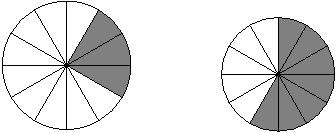Purpose:
You can help your child to order fractions that have the same denominator. For example: 1/12, 3/12, 7/12, 11/12.
What you need:
- A game board for each player
- Game cards
- Templates (PDF, 35KB) of the gameboard. These can be printed or hand made.
What to do:
Play the game “Place It" with your child.
- Each player needs a game board. The game can be played with two to four players.
- All the game cards are shuffled and spread out face down in the centre of play.
- Players take it in turns to turn over a game card and, if possible, place it on their game board. Fractions must be placed on the game board in order, from smallest fractions on the left to largest fractions on the right, but need not be consecutive.
- If the card turned over by a player cannot be placed on their game board the player replaces the card in the centre of play and misses their turn.
- The winner is the first player to complete their game board, with fractions in order from smallest fractions on the left to largest fractions on the right. For example:

Note: Each fraction can appear only once on each game board.
If your child has difficulty placing the fractions in order you can draw a “pizza" to help them think about the size of the fractional pieces. For example, 3 twelfths, or 3 pieces of pizza, is less than 7 twelfths, or 7 pieces of pizza:

What to expect your child to do:
- Place the smaller fractions to the left of the game board and the larger fractions to the right.
- Recognise that when all the fractional pieces are the same size, i.e. twelfths, the more pieces you have the larger the fraction will be. For example 8 twelfths is larger than 3 twelfths.
Variations:
Use fractions with a different denominator, for example, use tenths instead of twelfths.
He Kupu Māori:
| twelfth | hautekau mā rua |
| three twelfths | toru hautekau mā rua |
| pizza | parehe |
| order, sequence | raupapa (hia)= |
| bigger | nui ake |
| smaller | iti ake |
He Whakawhitinga Kōrero:
- Riwhiriwhia ngā kāri. Horahia ngā kāri, ko ngā mata ki raro. (Shuffle the cards. Spread them out, face down.)
- Tangohia tētahi kāri, ka whakatakoto ai ki tētahi o ngā pouaka i tō papatākaro. (Pick up a card and place it on one of the boxes on your gameboard.)
- E tika ana kia piki haere te raupapa o ngā hautau mai i te mea iti i te taha mauī ki te mea nui i te taha matau. Nō reira, ko tēhea pouaka hei whakatakoto māu i tēnei hautau? (The fractions have to get bigger, from the smallest on the left to the largest on the right. So which box will you put this fraction on?
- Raupapahia ngā hautau mai i te iti ki te rahi. (Order the fractions from small to large.)
- Kāore e taea tēnei hautau te whakatakoto, kia tika tonu te raupapa o ngā hautau mai i te iti ki te rahi. (This fraction cannot be placed for the correct order from small to large.)
- Kua oti katoa ngā pouaka i taku papatākaro, nō reira, ko au te toa! (All of the boxes on my playing board are complete, so I win!)
- Kei a koe ināianei. (Your turn now.)
Download a file of this activity:
PDF (553KB)